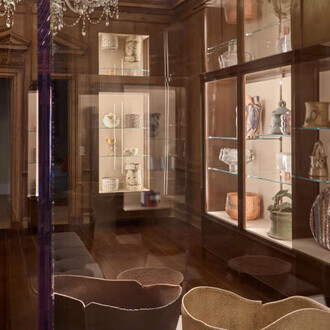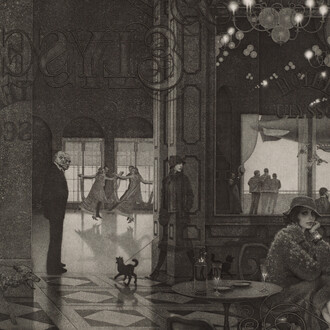The David Winton Bell Gallery (The Bell) at Brown University is pleased to announce the forthcoming exhibition Franklin Williams: It’s about love on view September 19 - December 8, 2024. Marking the first east coast institutional retrospective of octogenarian artist Franklin Williams (b.1940), It’s about love offers fresh insights into Williams’ vibrant, textured multimedia oeuvre created through a rigorous studio practice spanning sixty years. It’s about love will showcase 40 artworks, ranging from sculptures to complex multimedia canvases and works on paper, each bursting with color, texture, and organic forms. Often considered a precursor and contemporary of the Pattern and Decoration Movement of the 1970s as well as several other West Coast schools including California Funk and Nut Art, Williams’ work defies easy categorization. Painting and drawing incorporating the needlework, crochet, and other fiber-based skills he learned from his family as a child in rural Utah, Williams’ highly personal work employs motifs and shapes imbued with symbolism and sustains a tension between figuration and abstraction, rigor and whimsy while exploring themes of familial and romantic love, death, sorrow, and lust, with humor and tenderness.
“We are thrilled to showcase the life work of Franklin Williams at The Bell”, states Director of Exhibitions of the Brown Arts Institute (BAI) and Chief Curator of the Bell Gallery at Brown University Kate Kraczon. “It’s About Love honors Franklin’s six-decade dedication to the folk and craft traditions of his childhood and a singular commitment to making work exclusively for himself. His daily studio practice marks moments of pleasure, pain, and quotidian family life, while eschewing external pressure from institutional and market trends. The resulting oeuvre consists of a unique vernacular and expression of his ‘personal cosmos’, which as an artistic legacy is overdue for close examination”.
The survey is anchored by exploring the sixty years Williams has spent in a daily, meditative studio practice. Since 1970, Williams has lived and worked from his home in Petaluma, California, with his wife Carol Williams—his collaborator and studio manager. His studio is an extension of the home: the walls of his house are hung salon-style with ancestral heirlooms that inform his practice. His own paintings and drawings are surrounded by his mother, father, and paternal uncle’s handmade quilts, furniture, and artwork. Williams was raised in a home imbued with art and poetry, which deeply informed his emergence as a visual artist and has fueled his autobiographical orientation throughout his decades of art making. He was given a studio by his parents who encouraged the burgeoning artist and recognized his talents despite academic challenges due to undiagnosed color vision deficiency (CVD) and dyslexia. An auto-didact who learned to read in his mid-30s—even while teaching full time at the San Francisco Art Institute and California College of the Arts—Williams straddles a self-taught ethos suspicious of the international art world with a profoundly generous pedagogical career as a beloved teacher in the Bay Area.
“I still work as deep as I possibly can inward to where, now, I hear my own heart, and hear the whistling in my body, and sometimes I need nothing but what I am” states Franklin Williams.
While size, scale, and palette have varied over the years, Williams’ artwork retains a vibrant, even eccentric, use of color shaped by his color vision deficiency (CVD), which produces variants in color recognition outside of what is considered normative. His canvases are also embedded with an intensity of emotion. The delights of fatherhood and deep love of his wife reveal Williams’ work as diaristic. Carol inspires much of his figuration and nearly all of the femme-reading bodies in paintings such as Twins (Part one and two) (1976) and Standing figure (c. 1990s). These erotically charged objects are devotional as they entwine love and sexuality into vividly hued human forms and bodily organs to become portraits of intimacy and marriage as well as moments of mourning. Several works in the exhibition mark intense periods of pain, such as the loss of an infant daughter in Baby girl #2 (1970) and Baby girl #4 (1971); the passing of Williams’ father in Last gate (1982); and the looming death of his mother in Cutting apron strings (1982).
There are also joyous portraits of family exemplified in Pink tea (1972), as well as celebrations of the yearly international travel that punctuated their Petaluma life in Secret sweet Slovakia (2020) and Portrait five (2015). His playfulness with materials, subject matter, and color has endured from the earliest soft sculptures included in the exhibition through his most recent paintings and drawings including Fez feeds lovable beauty (2020) and Sensuous submission (2021). Williams approaches artmaking as an incredible gift; a nearly mystical process that channels what he refers to as “beauty, mystery, and myth” into visual form, capturing the highs and lows of a life immersed in love.
With this exhibition, The Bell is proud to honor Franklin Williams’ profound contributions and expanding influence in contemporary art practice—a presentation that exemplifies the institution’s commitment to commissioning projects and staging exhibitions with emerging and underrecognized artists that expand the interdisciplinary mission of university-wide incubator Brown Arts Institute.














